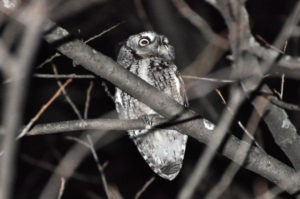Where have all the whip-poor-will’s gone? This is a common question I am confronted with. I think it is a good question and one that leads into a larger discussion question that asks “Are current bird monitoring programs capable of estimating population trends for nocturnal species”. While current standardized monitoring programs, such as Christmas Bird Count (CBC), Breeding Bird Survey (BBS), and Spring Bird Count (SBC), are exemplary monitoring programs, they take place primarily during daylight hours, so unfortunately they cannot reliably monitor population trends for cryptic, nocturnal birds. Anecdotally, we know some may be declining, and, because of this, many organizations throughout the U.S. and Canada have put together monitoring programs for nocturnal species that aim to generate statistically powerful data that can be used to generate population trends over a shorter period of time. If species are declining we can further investigate the causes and in turn try to make beneficial conservation management decisions.

In 2008 Illinois enlisted the guidance of ongoing nocturnal monitoring programs and piloted Monitoring of Owls and Nightjars in Illinois (MOON). MOON is a volunteer based program that occurs throughout the state of Illinois. MOON’s target species are breeding owls and nightjars. In Illinois we have four nocturnal owls that we monitor for; Barn Owl, Barred Owl, Great Horned Owl, and Eastern Screech-Owl. The Barn Owl is listed as threatened on the Illinois Endangered Species List. The Eastern Screech-Owl is found in low numbers according to BBS data, but population trends are absent. Barred Owl, which was once rare in the state, is now found throughout the state as is the Great Horned Owl. MOON also targets nightjars; Illinois has have three species: Eastern Whip-poor-will, Chuck-will’s-widow, and Common Nighthawk. Nightjars are aerial insectivores and aerial insectivores of North America are in decline and the reasons why are poorly understood. The Chuck-will’s-widow has recently been listed as threatened on the Illinois Endangered Species List. The state of the birds report listed Common Nighthawk as a species in steep decline. Audubon’s climate model projects the Eastern Whip-poor-will to lose 78% of its breeding range by 2080 and 55% of its non-breeding range. By establishing MOON census routes that are consistently monitored we seek to be able to not only track trends in abundance and distribution for these species but to also develop suitability models and best management practices for them. Volunteers are critical for this program to succeed.
Because these routes are run anywhere from dusk until dawn, as opposed to during daylight hours, it can be a challenge to recruit and retain volunteers. Unlike other monitoring programs, where you have to learn to identify a large number of birds species often by sight and sound, MOON volunteers only need to learn a small handful of calls. The calls of these birds are relatively simple to learn and fun to hear. Volunteers monitor routes located along suitable habitat for owls and nightjars 2 times from April to June when the moon is at least 50% illuminated. Routes are 9 miles long with 10 stops per route. MOON volunteers are also encouraged to record “other” species they hear during the listening period if they can identify the sounds. These additional data can give us insight into the life histories of other species.
Interested in becoming a part of the MOON team? We are always looking to recruit more volunteers, so if you would like to volunteer, please e-mail me. You can also visit our website.
by Tara Beveroth
